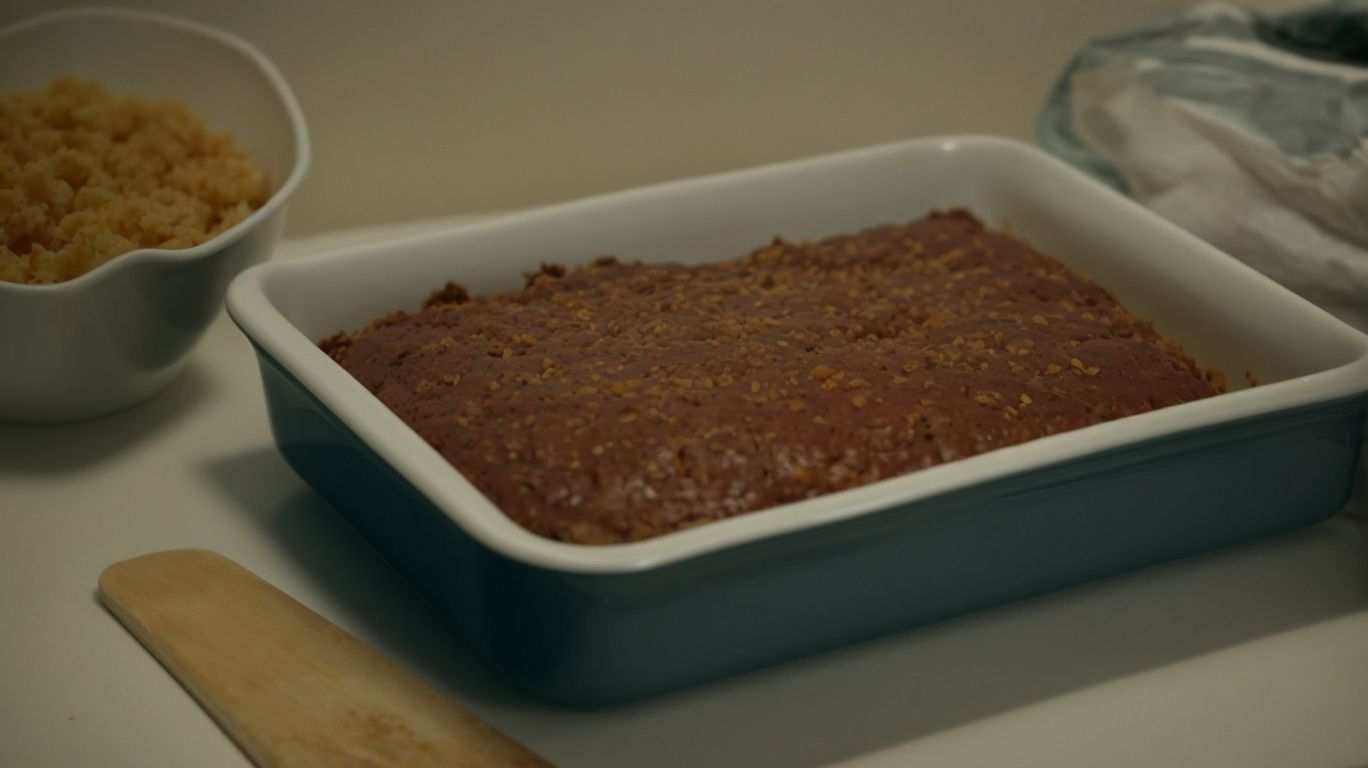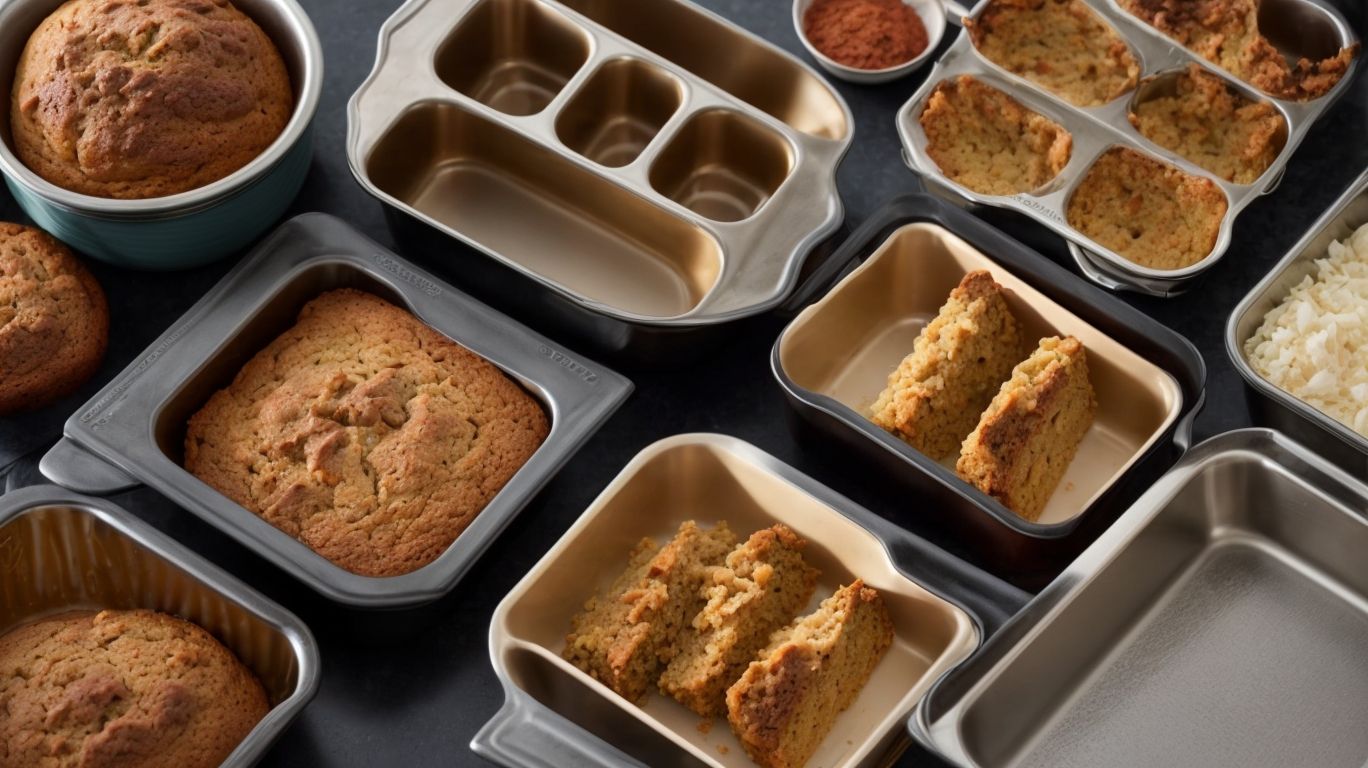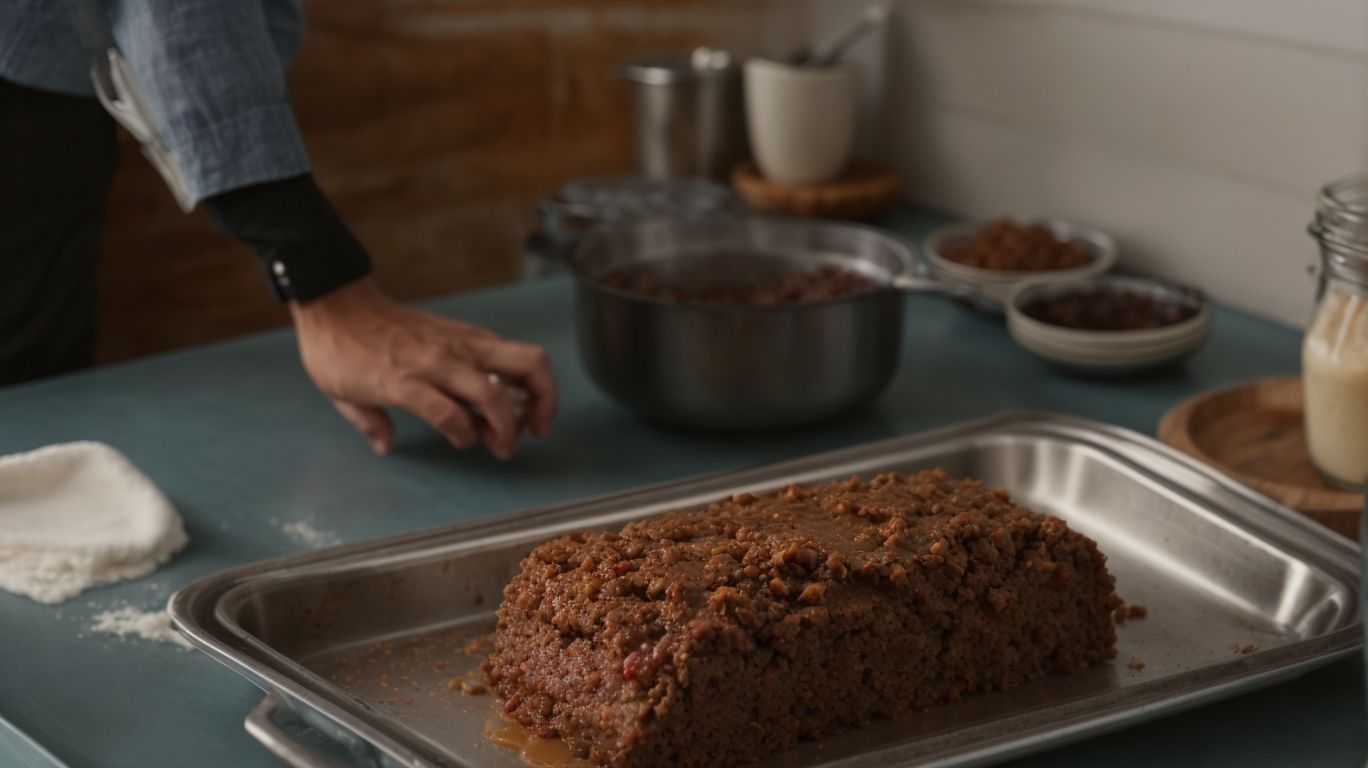How to Bake Meatloaf Without a Loaf Pan?
Are you wondering how to bake meatloaf without a loaf pan?
This article will explore the purpose of a loaf pan in baking meatloaf and the benefits of baking meatloaf without one. We will also discuss alternative baking vessels that can be used instead of a loaf pan, such as a baking dish, muffin tin, foil, or bread pan.
We will provide tips on how to prepare and bake meatloaf using these alternative methods. Let’s get started!
Key Takeaways:
What is a Loaf Pan?
A loaf pan is a kitchen utensil designed for baking meatloaf, providing a structured shape for the mixture to cook evenly.
Meatloaf is a classic comfort food consisting of a mixture of ground meat, oats, onions, and tomato juice.
Utilizing a loaf pan plays a crucial role in the meatloaf-making process. The pan’s structure ensures that the meatloaf retains its shape while cooking, resulting in a uniform texture and consistent flavor throughout. By containing the ingredients within its confines, the loaf pan helps the meatloaf cook evenly and retain moisture, essential for a juicy and flavorful final dish.
What is the Purpose of a Loaf Pan in Baking Meatloaf?
The purpose of a loaf pan in baking meatloaf is to shape and contain the mixture, ensuring it cooks uniformly and retains its desired texture and flavor.
When preparing a meatloaf mixture, a loaf pan acts as a mold, allowing the ground beef and pork to hold its form during the cooking process. This containment helps the ingredients meld together, enhancing the overall flavor profile.
Properly forming the meatloaf within the pan also aids in trapping juices, leading to a succulent and moist end result. The structure provided by the loaf pan allows for even heat distribution, preventing the outer layers from drying out before the center cooks through.
Why Bake Meatloaf Without a Loaf Pan?

Credits: Poormet.Com – George Davis
Baking meatloaf without a loaf pan offers the opportunity to experiment with different shapes and textures, allowing for unique flavor combinations and presentations.
When you opt for baking meatloaf sans a loaf pan, you have the flexibility to sculpt it into fun shapes like a heart, log, or even individual muffin-sized portions. This culinary journey allows you to blend diverse ingredients such as oats for added texture, tangy ketchup for a savory kick, or even incorporating mashed sweet potatoes for a tender consistency that perfectly complements the rich flavors of the meat. The absence of a traditional loaf pan liberates your creativity, transforming a classic dish into a culinary masterpiece that suits your personal taste preferences and aesthetics.
Benefits of Baking Meatloaf Without a Loaf Pan
Baking meatloaf without a loaf pan on a sheet pan can result in a crispy exterior while maintaining a moist and juicy interior, offering a delicious twist to the traditional method.
One of the key advantages of using a sheet pan instead of a loaf pan is the increased surface area, allowing the meatloaf to develop a perfectly caramelized crust that adds a delightful crunch to each bite. This method also ensures that excess fat drips away during baking, resulting in a healthier dish. The use of lean ground beef not only reduces the overall fat content but also enhances the flavors of the dish, making it a wholesome and flavorful choice for any meal.
What Can Be Used Instead of a Loaf Pan?
Instead of a traditional loaf pan, various alternatives such as a baking dish, muffin tin, foil, or bread pan can be used to bake meatloaf, each offering unique results in flavor and texture.
Choosing a baking dish allows the meatloaf to develop a slightly crisper exterior due to more surface area exposure to heat. On the other hand, using a muffin tin yields individual mini meatloaves, perfect for portion control or quick serving.
Wrapping the meatloaf in foil retains moisture and intensifies flavors, creating a juicy and tender result that is easy to customize with different seasonings and fillings.
A bread pan imparts a longer, narrower shape to the meatloaf, resulting in evenly cooked slices that are ideal for sandwiches or smaller portions.
Baking Dish
A baking dish can serve as a versatile alternative for baking meatloaf, allowing for the incorporation of ingredients like garlic, onion, and oats to create a delightful meal for the whole family.
One of the great advantages of using a baking dish instead of a traditional loaf pan for meatloaf is the flexibility it offers in ingredient choices. When preparing meatloaf in a baking dish, you have the freedom to experiment with various seasonings such as garlic and onion to enhance the flavor profile. You can incorporate oats for added texture and a healthy twist to the dish.
The larger surface area of a baking dish allows for more even cooking, ensuring that the meatloaf is cooked through perfectly without any raw spots. This method also offers the opportunity to easily baste the meatloaf with flavorful sauces or glazes, adding another layer of taste to the dish.
Muffin Tin
Utilizing a muffin tin for baking meatloaf creates individual portions that are crispy on the outside and deliciously moist on the inside, offering a unique texture and presentation.
Since the meatloaf mixture is divided into small sections, it cooks quicker and more evenly, ensuring each mini meatloaf is perfectly cooked.
In addition, using oats as a binding agent adds a wholesome touch and a light, airy texture to the meatloaf, balancing out the rich flavors.
Eggs act as a natural emulsifier, keeping the meatloaf moist and tender while enhancing its flavor profile.
Foil
Wrapping meatloaf in foil offers a convenient method for baking, enhancing the flavors and textures of the dish while keeping it moist and juicy.
When you use foil as a baking vessel for your meatloaf, it acts as a barrier, sealing in the juices and flavors, preventing them from escaping during the cooking process. This results in a more succulent and flavorful end product. The foil also helps to evenly distribute heat, ensuring that the meatloaf cooks uniformly. When you mix ingredients like ketchup and ground beef for your meatloaf, the foil helps to intensify the flavors by allowing them to meld together harmoniously.
Bread Pan
Employing a bread pan as a substitute for a loaf pan in baking meatloaf allows for the incorporation of key ingredients like onions, tomato juice, garlic, salt, and pepper, resulting in a flavorful and aromatic dish.
Onions, when finely chopped and mixed into the meatloaf mixture, impart a sweet and savory flavor that melds beautifully with the other ingredients. The addition of tomato juice not only keeps the meatloaf moist during baking but also adds a tangy undertone that enhances the overall taste.
The minced garlic provides a delightful hint of pungency to the dish, while a generous sprinkle of salt and pepper helps to elevate the flavors and ensure a well-seasoned meatloaf. When baked in a bread pan, the meatloaf takes on a charming shape that is perfect for slicing into neat portions.
How to Prepare the Alternative Baking Vessels

Credits: Poormet.Com – Russell Smith
Preparing alternative baking vessels for meatloaf involves greasing the pan, lining it with parchment paper, and shaping the meatloaf mixture to ensure even cooking and optimal flavor distribution.
To begin, start by selecting an appropriate baking vessel; this could be a loaf pan, a baking dish, or even a muffin tin for individual portions. Once you’ve chosen your vessel, make sure to generously grease the surface to prevent sticking. Next, carefully line the pan with parchment paper, ensuring that it covers the bottom and sides completely.
When shaping the meatloaf mixture, aim for a uniform thickness to promote consistent cooking. Avoid packing the mixture too tightly, as this can result in a dense, dry meatloaf. Instead, gently shape it into a loaf or patties, depending on your preference.
Properly preparing your baking vessel is crucial for achieving a moist and flavorful meatloaf that is cooked to perfection. Taking the time to grease, line, and shape will pay off in the end with a delicious and visually appealing dish.
Greasing the Pan
Greasing the pan before baking meatloaf ensures that the dish does not stick and helps in achieving a desirable texture and flavor profile, especially when using ingredients like sweet potatoes, olive oil, and garlic granules.
In the world of cooking, the simple act of greasing the pan plays a crucial role in the success of your dish. When making meatloaf, the combination of sweet potatoes, olive oil, and garlic granules not only adds a unique flavor profile but also contributes to the overall texture. Sweet potatoes, with their natural sweetness and moisture, help in keeping the meatloaf tender and juicy. The olive oil provides a rich, savory note while ensuring the loaf doesn’t dry out during baking.
Lining with Parchment Paper
Lining the baking vessel with parchment paper before adding the meatloaf mixture helps in preserving moisture, enhancing texture, and preventing sticking, ensuring a flavorful outcome with ingredients like oats, onions, and tomato juice.
By creating a barrier between the meatloaf and the pan, parchment paper acts as a protective shield that locks in the natural juices of the meat, keeping it succulent and tender throughout the cooking process. This simple technique not only promotes even cooking but also aids in maintaining the integrity of the meatloaf’s structure, resulting in a perfectly moist and cohesive dish.
The parchment paper absorbs excess grease, helping to avoid a greasy bottom and facilitating clean-up afterwards. The non-stick surface of the paper also prevents the meatloaf from sticking to the pan, making it easier to transfer and slice without any messy mishaps.
Shaping the Meatloaf
Properly shaping the meatloaf mixture before baking ensures even cooking, optimal flavor distribution, and a cohesive family dinner experience with ingredients like eggs, oats, and garlic.
Shaping the meatloaf mixture is a crucial step as it not only helps in maintaining the shape of the loaf during baking but also allows for thorough cooking. The uniform shape ensures that the meat cooks evenly, preventing undercooked or overcooked sections. Shaping the meatloaf mixture aids in incorporating all the flavors of the ingredients, such as the savory notes from garlic and the binding effect of eggs.
The process of shaping the meatloaf mixture contributes to the overall dining experience by presenting a visually appealing dish for the whole family to enjoy. When each slice holds together beautifully, it adds to the communal aspect of sharing a meal, bringing everyone together around the dinner table.
Tips for Baking Meatloaf Without a Loaf Pan
When baking meatloaf without a loaf pan, it’s essential to adjust the baking time, check for doneness, and employ techniques to prevent the meatloaf from falling apart, ensuring optimal flavor and texture.
One effective way to ensure your meatloaf holds its shape without a loaf pan is to form it into a free-form loaf on a baking sheet. This method allows for even cooking and caramelization on the edges. To maintain moisture, consider adding a moisture barrier such as a layer of bacon strips on top or a brush of ketchup-glaze to seal in the juices.
Periodically basting the meatloaf with a glaze or sauce during baking not only adds flavor but also helps in keeping it moist. Be sure to use a food thermometer to check the internal temperature, aiming for at least 160°F for safe consumption.
Adjusting Baking Time
Adjusting the baking time when baking meatloaf without a loaf pan is crucial to ensure that all ingredients, including ground beef and pork, are cooked to perfection, resulting in a flavorful dish.
When cooking meatloaf without a loaf pan, the shape might vary, which can affect the cooking time. It’s essential to monitor the internal temperature of the meatloaf regularly to prevent undercooking. Ground beef and pork need to reach a safe internal temperature to eliminate any harmful bacteria and ensure a juicy texture. Giving the meat enough time to cook also allows the flavors to meld together, creating a more delicious end product.
Checking for Doneness
Regularly checking for doneness while baking meatloaf without a loaf pan helps ensure that ingredients such as eggs, oats, and garlic are cooked through, contributing to the desired texture and flavor.
By monitoring the readiness of the meatloaf as it bakes, you can prevent overcooking or undercooking, which may result in a dry or unappetizing dish. The eggs, when fully cooked, help bind the ingredients together, creating a moist and tender texture. The oats absorb moisture during baking, adding both texture and fiber to the meatloaf. The garlic undergoes a transformation as it cooks, infusing the dish with its aromatic flavors.
Preventing the Meatloaf from Falling Apart
To prevent meatloaf from falling apart during baking without a loaf pan, using binding ingredients like ground beef, oats, and appropriate seasoning is essential for maintaining the dish’s texture and flavor.
Ground beef acts as the main binding agent due to its fat content and ability to hold ingredients together. Combining it with oats adds texture and moisture, preventing the meatloaf from becoming too dense or dry. Seasoning such as salt, pepper, garlic, and herbs not only enhance the flavor but also contribute to the cohesion of the mixture. Mixing the ingredients gently helps avoid overworking the meat, which can lead to a crumbly texture post-baking.
Allowing the meatloaf to rest before slicing allows the juices to redistribute, resulting in a neater presentation.”
Conclusion
In conclusion, baking meatloaf without a loaf pan opens up a world of possibilities to enhance the recipe’s flavor, texture, and overall appeal, with ingredients like oats and onions playing a crucial role.
One of the key benefits of forgoing the loaf pan is the ability to easily customize your meatloaf to suit your preferences. You can experiment with various seasonings, spices, and fillings, such as cheese, mushrooms, or even barbecue sauce, to create a unique and flavorful dish.
By baking the meatloaf free-form on a baking sheet or in a skillet, you allow the meat to develop a delicious crust all around, adding a satisfying texture to each bite.
Using oats instead of breadcrumbs can introduce a nutty flavor and a slightly different texture to the meatloaf. Onions, when caramelized before mixing into the meat mixture, bring a touch of sweetness and depth of flavor.
Frequently Asked Questions
What is the best alternative to using a loaf pan when baking meatloaf?
The best alternative to using a loaf pan when baking meatloaf is to shape the meat mixture into a loaf shape and place it on a baking sheet lined with parchment paper.
Can I use a casserole dish instead of a loaf pan for baking meatloaf?
Yes, you can use a casserole dish as an alternative to a loaf pan for baking meatloaf. Make sure to grease the dish well before adding the meat mixture.
How do I prevent the meatloaf from sticking to the baking sheet?
To prevent the meatloaf from sticking to the baking sheet, line it with parchment paper or aluminum foil before placing the meatloaf on it.
What is the best way to shape a meatloaf without a loaf pan?
The best way to shape a meatloaf without a loaf pan is to use your hands to form a loaf shape. You can also use a round cake pan or a bread tin as a mold for shaping the meatloaf.
Can I use a bundt pan to bake meatloaf?
Yes, you can use a bundt pan to bake meatloaf. Grease the pan well before adding the meat mixture, and make sure to fill it only halfway to prevent overflow.
How do I know when the meatloaf is fully cooked?
You can check the internal temperature of the meatloaf with a meat thermometer. The temperature should reach 160 degrees Fahrenheit for the meatloaf to be fully cooked. You can also insert a knife into the center of the meatloaf, and if the juices run clear, it is ready to be taken out of the oven.

